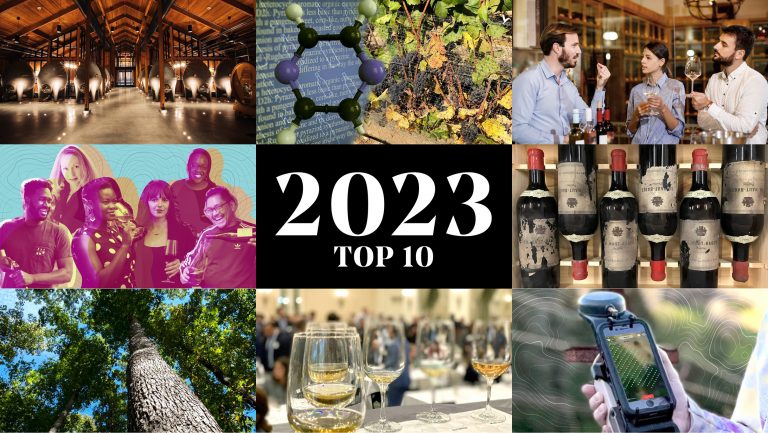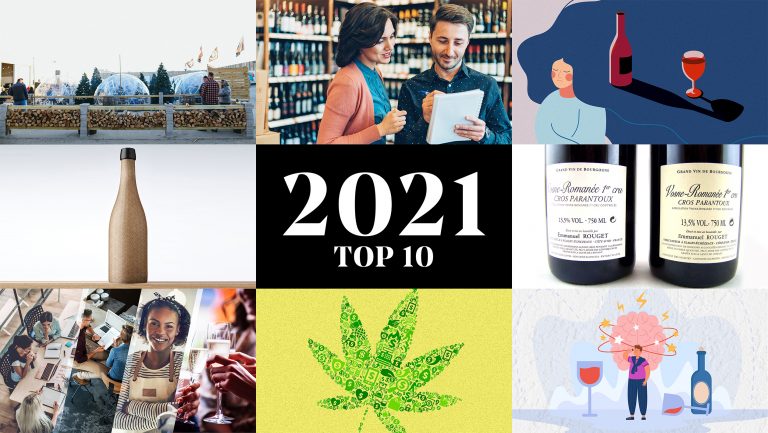It’s been a year of growth and change across the beverage industry. Rising prices, labor shortages, and the climate crisis continue to present complex challenges to drinks professionals, but these challenges have been matched by a new energy behind finding innovative solutions.
Those efforts are evident in the stories that SevenFifty Daily readers turned to in 2023. Reporting on new sustainability initiatives ranked highly, such as Betsy Andrews’ piece about the spirits industry’s role in preserving the white oak or Samantha Cole Johnson on growing momentum for recollection and reuse in wine. And so did stories that dealt with inclusivity and accessibility in the industry, such as Tina Caputo’s feature on rethinking the language of wine.
But growth requires learning, and amongst our most popular stories are those that serve to educate, whether it’s our drinks career coverage, offering practical advice from beverage professionals, or our many deep dives into various aspects of winemaking, from co-fermentation to concrete eggs. Now that 2023 is over, take a look at the stories that resonated most with SevenFifty Daily readers in the past year.

Don’t miss the latest drinks industry news and insights. Sign up for our award-winning newsletters and get insider intel, resources, and trends delivered to your inbox every week.
10. The Changing Landscape of Wine Education
Shifts in traditional educational bodies and a wave of new resources have improved access to wine education—but is it enough?—By Caitlin Miller
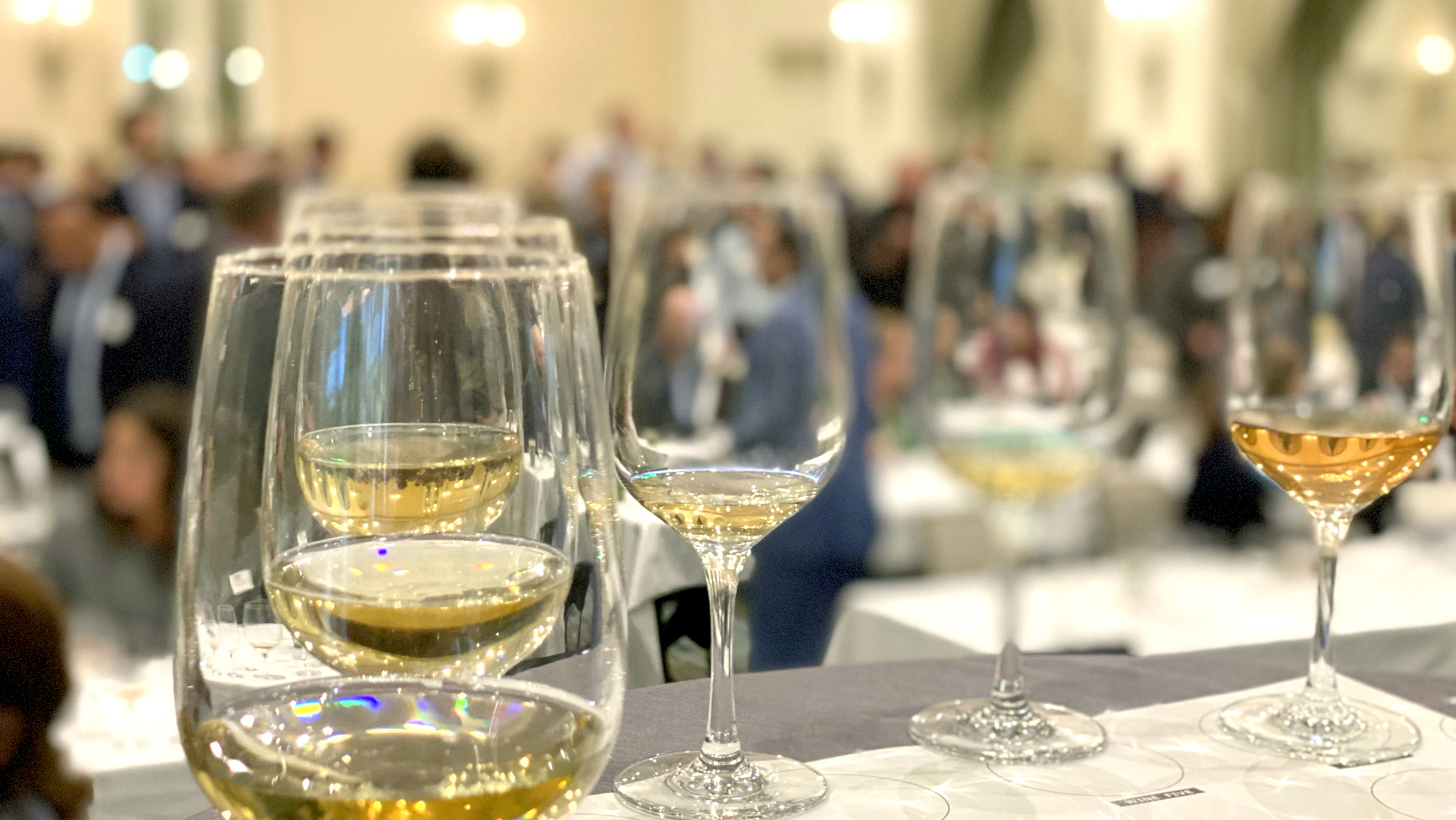
Over the past several years, broad cultural movements—#MeToo, Black Lives Matter, the shift to remote work—have impacted the wine industry as much as any other. Within the wine education space specifically, the impacts of these movements have been widespread, spurring change at almost every level—with no signs of slowing down.
“This is where wine education is changing,” explains Mary Gorman-McAdams, MW, an independent consultant, educator, and Bordeaux specialist and the former director of the International Wine Center (IWC) in New York City. “You’re having this migration from it being this elite language that you’re almost born with, to something for people who have never had anything to do with [wine].”
From where to find educational resources to who can access them—and even the importance of formal certifications themselves—the wine education landscape looks significantly different than it did just five years ago. SevenFifty Daily spoke with schools, teachers, students, and organizations to understand what’s changed, what’s working, and where wine education goes from here. [Read more]
9. Could Reuse be the Future of Wine Packaging?
Reuse, once prevalent, is on the rise as the notion of a circular economy gains traction amongst wine industry professionals—and consumers—in search of sustainable alternatives—By Samantha Cole-Johnson

Bernard Grafé, the fourth-generation proprietor of the négociant-éleveur Grafé Lecocq, runs his family’s business using the same model on which it was founded in 1879. “We have always worked with producers in France to buy raw wines to age and bottle in the Belgian market. Ninety percent of our sales are in Belgium and all sales are within 200 kilometers. This enables a circular system of recollection and reuse. Now people think this system is revolutionary,” says Grafé, smiling in amusement.
Grafé is right to smile. The reuse system employed by his family, which has been fully functioning for over 100 years, is currently keeping his glass costs reasonable in a country that is experiencing glass shortages and price hikes due to the war in Ukraine. But even before that was an issue, Grafé’s family employed reuse because it has the lowest carbon footprint of any packaging option. “When you manufacture a glass bottle you need temperatures of 1,480 Celsius [2,700 Fahrenheit] for 24 hours, a bit less if it’s recycled material. We wash for 30 minutes at a maximum temperature of 80 Celsius [176 Fahrenheit]. I take into account that sometimes we need to buy new bottles, but even so our carbon footprint is 10 times lower than it would be,” says Grafé.
As increasing numbers of people around the globe wake up to the realities of our changing climate and the effect of single-use packaging, notably heavy glass, why isn’t reuse more prevalent? [Read more]
8. Bourbon, Biodiversity, and the Quest to Save American Oak Forests
Without the success of the White Oak Initiative—a coalition of distilleries, cooperages, and foresters—there will be too few trees for their current widespread use—By Betsy Andrews

Erica Tergeson has worked as a lobbyist on Capitol Hill for more than two decades. But the tools she previously used weren’t as congenial as they are now in her gig with the White Oak Initiative (WOI). “There’s no easier way to explain the issues to a Hill staffer, or Congressman, or Senator than having them taste some bourbon and then talk about why this is important,” she says.
Comprising a coalition of researchers, conservationists, foresters, policymakers, and big players from industries including cooperage and distilling, the WOI’s mission is to secure the future of the United States’ oak forests and a key species in them—the white oak. The tree from which bourbon barrels are made is in jeopardy. If oak forests are not properly managed, we could see an end to the species’ viability as a usable product within a generation. States need funding to support landowners’ care of their woods. Tergeson is lobbying for money for white oak renewal in the upcoming Farm Bill, the next appropriations bill, and the Trillion Trees Bill, which is aimed at climate sequestration—and she works with a bottle in hand.
Indeed, if you want to create a buzz around a sleeper issue like forestry management, invite Brown-Forman, Beam-Suntory, and Sazerac to the party. “There’s a different level of awareness and funding for the issue because these companies care about having white oak in the future,” says Tergeson. “Bourbon makes forestry cool.” [Read more]
7. A Game-Changing New Vineyard Management Technology
A smartphone app called Sentinel Vine Manager generates revolutionary vineyard maps that track individual vine histories using Global Navigation Satellite Systems and cloud analytics—By Samantha Cole-Johnson

Every summer, harvest interns walk vineyard rows with clipboards, pens, clickers, and flagging tape. They count vines, then clusters, to estimate potential yields. If they’re at a premium estate winery where loss in productivity has large financial implications, they flag unhealthy vines and count out points on painstakingly crafted dot maps to mark the location of these vines. At the end of the harvest, the maps and notes are compiled into a binder and left in a vineyard office to collect dust. The data collected is frustratingly underutilized.
Until recently, the lack of a vineyard-specific application combining geographical mapping and data analytics made it difficult for wineries to track data beyond bulk statistics, such as the number of virus-infected vines or the number of non-producing vines. And without the geographical context of which vine was infected or non-producing, the data had little impact beyond yield estimation.
Now, a new software is bridging this gap, allowing vineyard managers to make data-informed decisions on irrigation, pruning, interplants, and more. [Read more]
6. Navigating the Wine Sales Rep Pay Landscape
From salary structures to securing other benefits, here’s what you need to know about negotiating a job offer in wine sales—By Kelly Magyarics

Meeting with sommeliers, restaurant wine buyers, and retail shop owners to taste through your company’s portfolio and convince them why they deserve space on their shelves or their list is the core undertaking of the wine sales rep. It’s a role that requires commitment and working often unconventional hours.
“Understand that as a distributor rep you will be working nights and weekends to drive sales numbers and earn a reasonable living,” says Joshua Blissett, the portfolio manager for Winebow, who has 13 years of industry experience. “No good sales rep ever created success sitting at home on their computer. Sales are done face-to-face.”
But before the networking, educating, and selling can begin, you need to secure a role with an importer or distributor—a process that involves careful logistical considerations. SevenFifty Daily asked four salespeople with decades of experience for their advice and best practices on getting what you want—and need—to succeed and thrive as a sales rep in the wine industry. [Read more]
5. Germany Is Driving the Quality Revolution for Non-Alcoholic Wine
By focusing on quality base wines and technological advancements, Germany is building on its long history of non-alcoholic wine production—By Valerie Kathawala
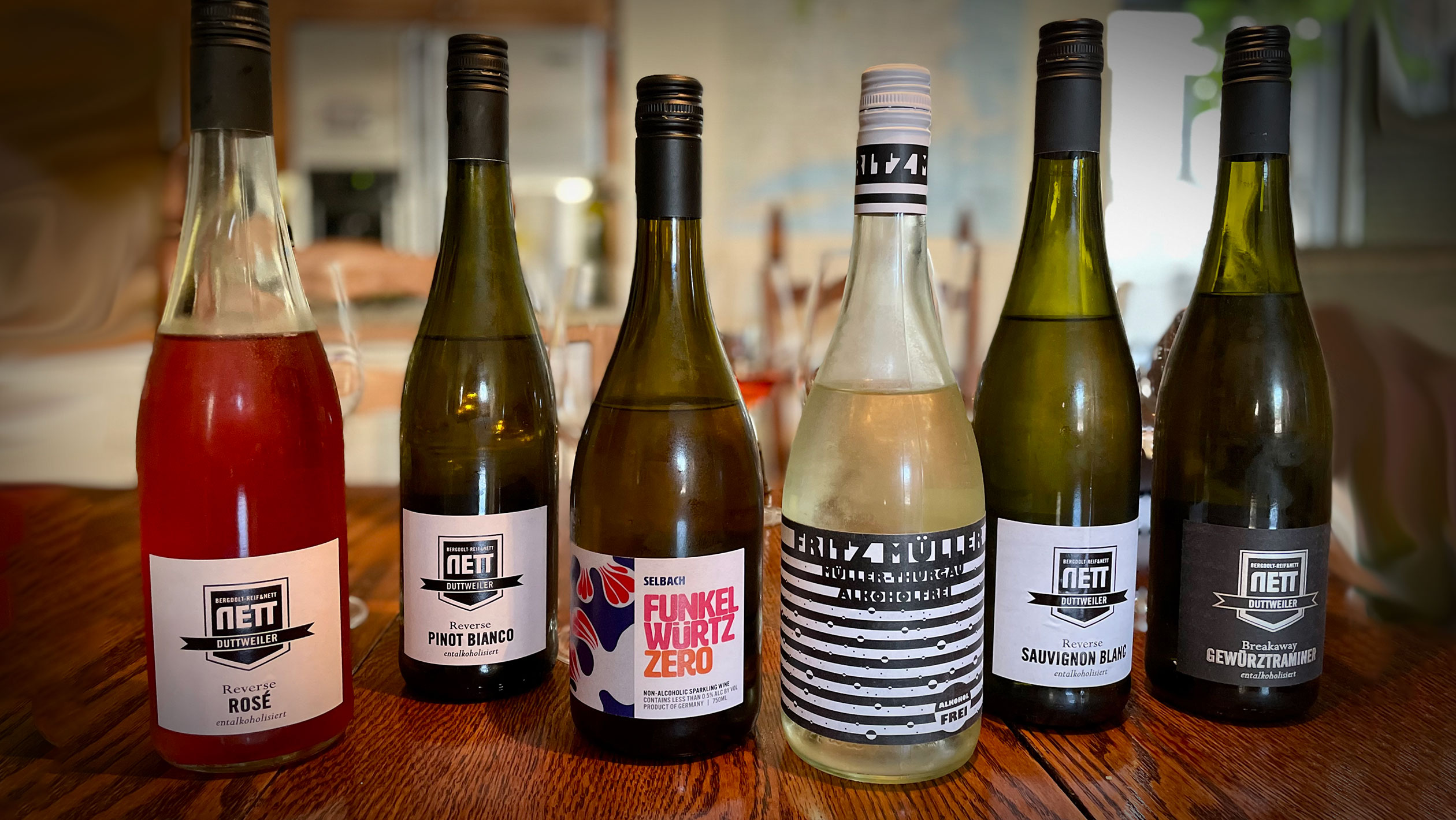
When Maria Jung set out to make customary sales calls for her family’s wine estate, she did not expect to be met with refusals. But she returned home to report a disappointing drop in purchases among regular customers. They were, they had told her, avoiding alcohol for health reasons. Jung considered the problem. She proposed that the family try an experiment. Why not dealcoholize their wines in the distillery they also operated? Within a few years, the estate was making the world’s first non-alcoholic wines under a patented process.
This is not, however, the story of an innovative winery responding to modern wellness culture. The year was 1900, and the place was Rüdesheim am Rhein, Germany.
That very early adoption is now paying off. Today, some 100 German wineries, from co-ops to international flagships, offer non-alcoholic wines of increasingly impressive quality. One is Weingut Leitz, the U.S. market leader in this category, which sends its wines to be dealcoholized just a few kilometers down the road—to Maria Jung’s great-grandson. [Read more]
4. Why Winemakers Are Split on the Benefits of Concrete Eggs
Some winemakers promise this increasingly popular fermenting and aging vessel offers softer tannins and greater depth of flavor—but others are on the fence—By Kate Dingwall

Egg-shaped vessels are not new options for fermenting or aging wine. In fact, they’re one of the oldest wine vessels in the world, found amongst the ruins of ancient Georgia, Spain, and Armenia. In 2001, Rhône winemaker Michel Chapoutier tweaked the shape with the help of the French company Nomblot, designing an egg-shaped concrete tank in hopes that the spherical shape would channel celestial energy. Do these tanks converse with the cosmos? It remains a mystery, but the egg shape does allow for constant movement and continuous flow—benefits international winemakers are finding increasingly appealing.
Chapoutier was initially drawn to the concrete egg because of its shape—oblong and curved, with a smooth internal surface and a complete lack of corners. Principles of thermodynamics dictate that the continuous surface of the egg shape creates a vortex within the fermenter, allowing for the wine to move freely and the lees to suspend within the wine. “The concave shape of the egg adds a natural bâtonnage, rolling the lees in the bottom of the tank,” says third-generation winemaker Sebastian Zuccardi of Argentina’s Zuccardi.
The shape—a nod to Roman amphora and other ancient vessels—and the depth of the concrete also allows for lower, more stable temperatures during fermentation, removing the need for artificial cooling. Compared to other clay vessels, Chapoutier’s main tweak to the tank was swapping in concrete—a neutral material that doesn’t impart extra flavors—over clay. Nombolt uses cement made from Loire sand, while Zuccardi uses rocks and clay from nearby rivers, adding an extra element of place to his wines. [Read more]
3. The Science of Pyrazines in Wine
Understanding the divisive aroma compounds best known for creating green notes like bell pepper and grass in Bordeaux grapes—By Alex Russan
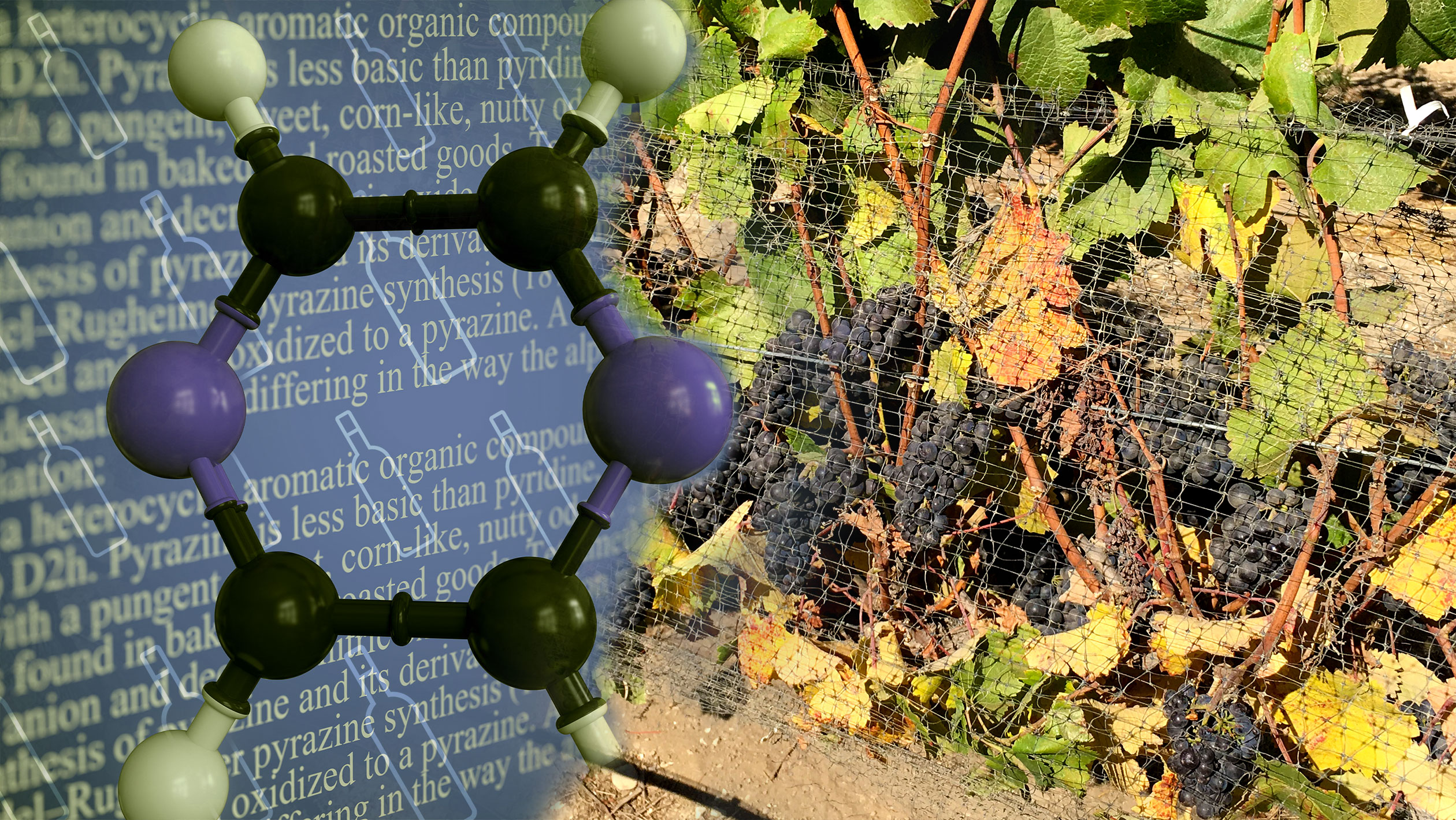
Methoxypyrazines (MPs)—often just referred to as pyrazines by wine professionals—are some of the most distinctive and divisive aroma compounds in wine. They cause many “green” aromas in wine: bell pepper, jalapeño, grassiness, and earthy or herbal aromas. Their management is a particular consideration with a widespread and genetically close group of grapes: Cabernet Franc, Sauvignon Blanc—as well as their progeny Cabernet Sauvignon—Merlot, Carménere, and Sémillion.
MPs are polarizing, and not just among wine drinkers: most winemakers want nothing to do with them, while others appreciate what they bring to the glass. The vineyard is where MP impact is largely determined, although red wine structure can influence how they’re expressed in the glass. MPs can be affected by, and have an effect on, a myriad of other aromas in a wine.
Nitrogen is the nutrient most associated with green plant growth, so it’s no surprise that MPs, which cause green, plant-like aromas, are nitrogenous. The MP that most affects wine is 3-Isobutyl-2-methoxypyrazine (IBMP), as it is found at concentrations above sensory threshold levels most frequently. There are “other MPs, similar in character and potency, to IBMP, but usually lower in abundance, and mainly related to inclusion of grape stems during fermentation,” notes David Jeffery, Ph.D., an associate professor in wine science at the University of Adelaide, and the co-author of Understanding Wine Chemistry. The other MPs that may reach sensory threshold concentrations in wine are IPMP (3-isopropyl-2-methoxypyrazine, which also results from ladybug taint), IBHP (3-isobutyl-2-hydroxypyrazine), and SBMP (3-sec-isobutyl 2-methoxypyrazine). [Read more]
2. The Science of Grape Co-Fermentation
Researchers and winemakers weigh in on how the centuries-old practice of fermenting white and red grapes together affects a wine’s color, flavor, and texture—By Jacopo Mazzeo
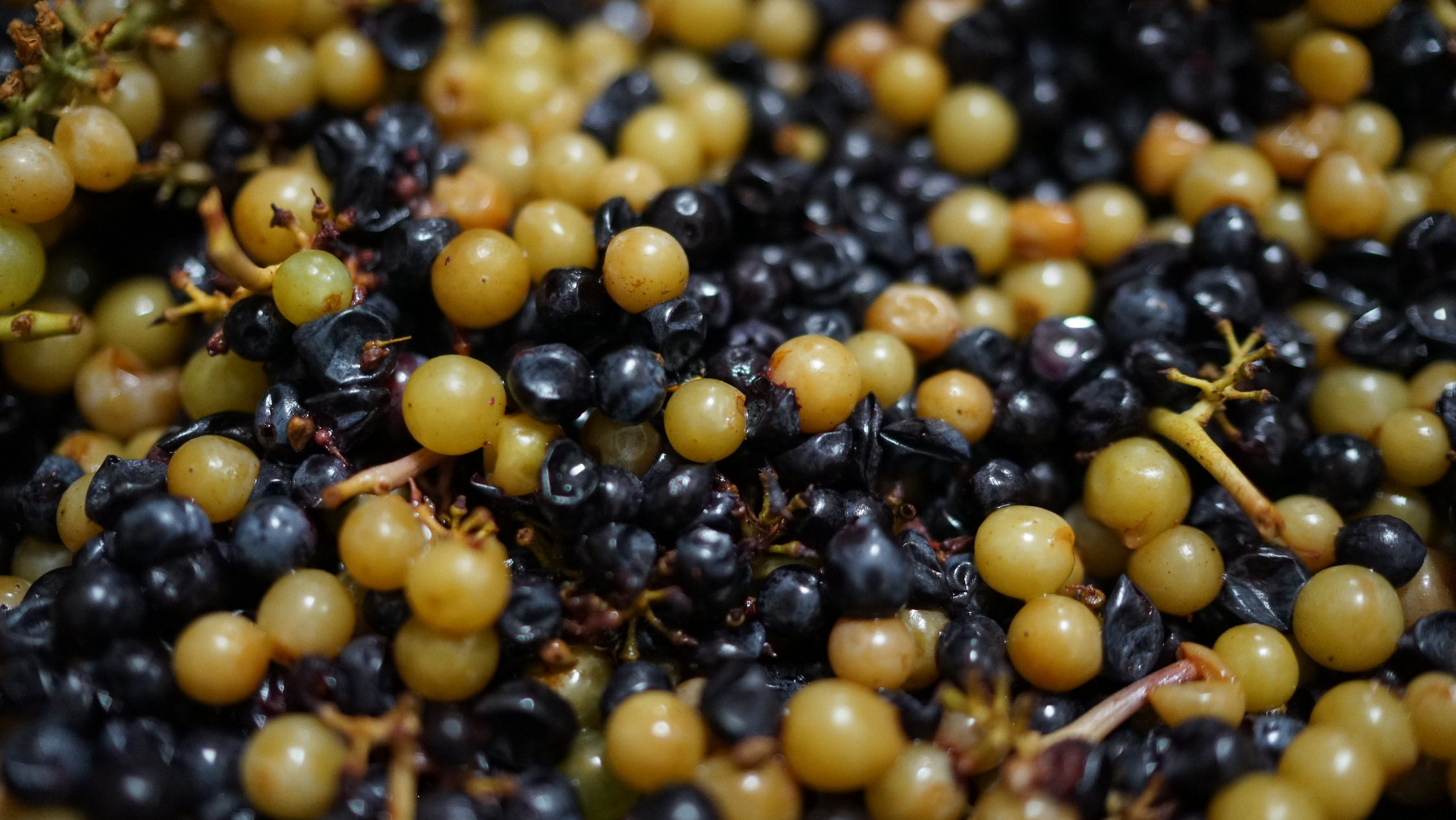
In a wine industry driven by an increasing fixation on single-origin and single-variety expressions, some long-standing winemaking practices would be implausible if introduced today, such as Porto’s unspecified field blends or Champagne’s intra-regional cuvées. The co-fermentation of white and red grapes is similarly unusual by today’s standards (although co-fermenting varieties of the same color is a more common practice). It has comparable historical value to the production methods of Porto or Champagne, yet perhaps lesser renown.
Much of today’s red wine is made exclusively with red-skinned grapes, but co-fermenting varieties of different colors is still allowed by a number of European denominations, and is occasionally employed in the New World, too. It is widely practiced across the Rhône Valley, including in Côte-Rôtie, where up to 20 percent Viognier can be added to Syrah, and Châteauneuf-du-Pape. In Burgundy, a portion of white grapes can still be used in red wines of any quality level, though this doesn’t happen very frequently. In Rioja’s Basque enclave of Alavesa, winemakers still regularly use Viura or Malvasia to round off their younger reds. Portugal even has a distinct term for this style of wines—palhete—whose history can be traced back hundreds of years, as 18th-century wine merchant John Croft documents in his Treatise on the Wines of Portugal.
Despite several academic studies on the subject, the effects of co-fermenting different grape varieties is still debated. Some researchers—and winemakers—find that co-fermentations result in noticeable differences in the final wine, while others are less convinced. SevenFifty Daily spoke with several experts to gain a better understanding of the science behind this ancient winemaking technique. [Read more]
1. Why Industry Professionals Are Rethinking the Language of Wine
To become more inclusive and accessible, a growing industry movement is questioning traditional, often Eurocentric wine descriptors both in the classroom and on the floor—By Tina Caputo

If you’ve ever reviewed tasting notes for Sauvignon Blanc, you’ve undoubtedly encountered the gooseberry. Common across Europe, this tart and tangy fruit is regularly referenced in wine reviews and descriptors despite the fact that few people in the United States have ever met a gooseberry in real life.
Though the use of such Eurocentric descriptors has been common practice in the U.S. for decades, the tide is turning as the nation’s population becomes more racially and ethnically diverse.
The U.S. Census Bureau projects that by 2028, nearly 15 percent of the country’s residents—a higher percentage than any time since 1850—will have been born in another country. As the non-Hispanic white population shrinks over the coming decades, the federal agency expects the population of mixed-race people to become the nation’s fastest-growing racial or ethnic group, followed by Asians and Hispanics. By 2045, the report forecasts, whites will no longer make up the majority of the U.S. population.
Now, as the U.S. wine industry recognizes the need to engage younger, increasingly multicultural consumers, forward-thinking industry professionals are calling for a more inclusive wine lexicon that reflects the country’s current and future demographics. [Read more]

Dispatch
Sign up for our award-winning newsletter
Don’t miss the latest drinks industry news and insights—delivered to your inbox every week.


